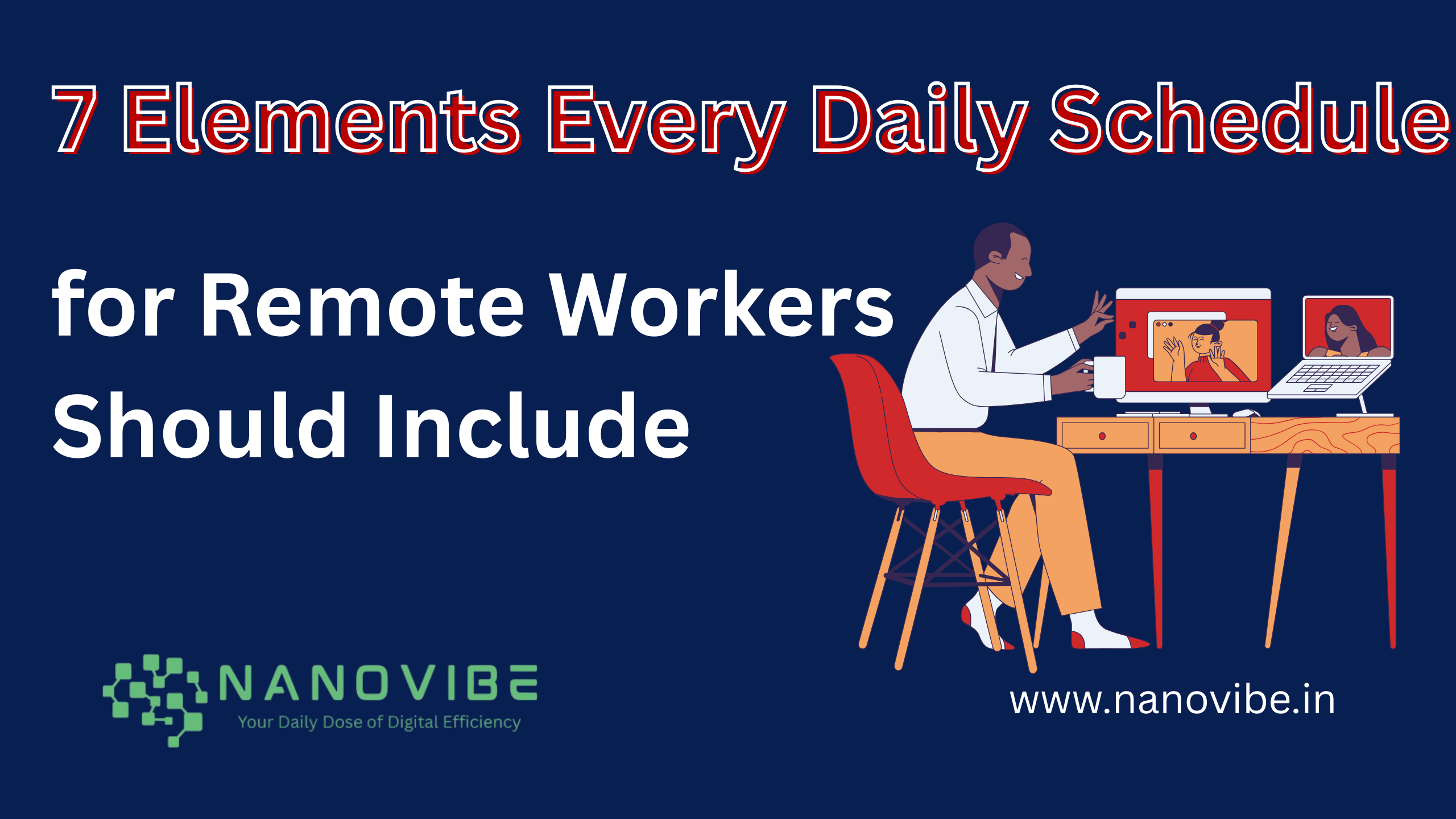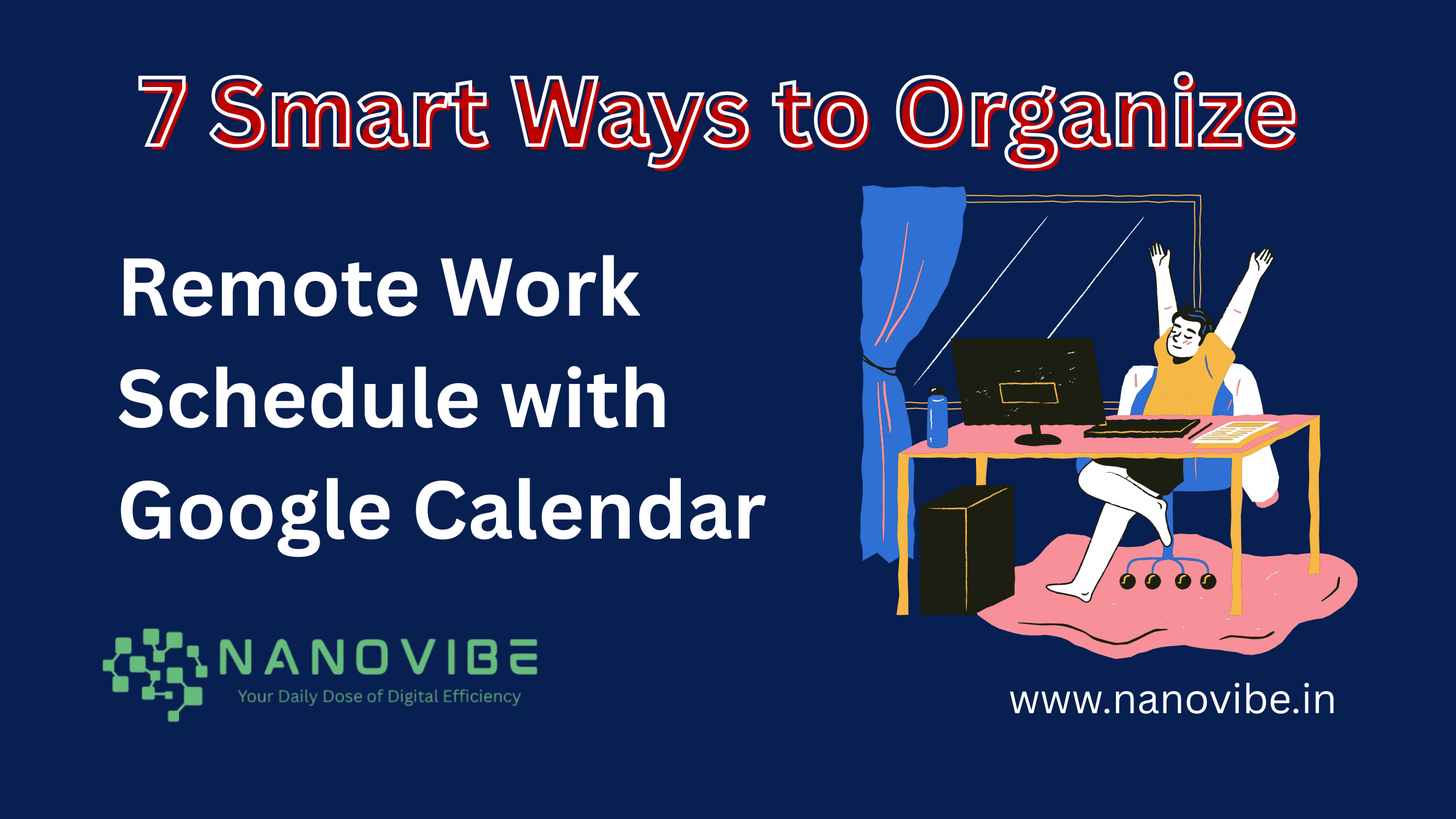Remote work may seem like the dream flexible hours, no traffic, and the freedom to wear pajamas all day but the truth is, it comes with its own set of hidden challenges. Without a clear routine, even the most ambitious professionals can find themselves trapped in a cycle of distraction, procrastination, and burnout. The kitchen is only steps away. So is the TV. And before you know it, the lines between “home” and “office” have completely blurred.
In this new normal, where more people are choosing or being asked to work from home, the need for a dependable structure has never been more critical. A well-designed daily routine doesn’t just help you get things done it protects your mental space, supports your well-being, and gives you back a sense of control in a boundary-less environment.
But here’s the thing: you don’t need a rigid, minute-by-minute schedule to succeed. What you need is a realistic, personalized system that works with your natural energy, lifestyle, and work demands. That’s where a thoughtfully crafted daily schedule for remote workers comes in.
This isn’t about trying to replicate an office routine at home. It’s about optimizing your day around focus, flow, and freedom. With the right approach, you can take full advantage of remote work without sacrificing productivity or peace of mind.
Daily Schedule for Remote Workers
In this article, we’ll walk you through a complete, actionable routine designed to help you stay organized, focused, and motivated throughout your remote workday no matter your job, location, or time zone.
Did you know? A 2023 report by Owl Labs found that 67% of remote workers struggle with maintaining consistent daily routines and 42% report reduced productivity due to lack of structure. With remote work becoming the norm rather than the exception, developing a sustainable, focused, and well-organized daily schedule is no longer optional it’s essential for long-term success.
Why You Need a Structured Routine as a Remote Worker
Without the framework of an office setting, remote workers can quickly fall into unhealthy work patterns working irregular hours, skipping breaks, or procrastinating. A clear daily structure brings numerous benefits:
- Improved productivity
- Better work-life boundaries
- Reduced stress and burnout
- More consistent output
- Increased job satisfaction
A daily schedule for remote workers isn’t about rigidity it’s about creating a rhythm that promotes flow, focus, and freedom.

The Ideal Daily Schedule for Remote Workers
Remote work gives you freedom but without structure, that freedom can become chaotic. Here’s a deeply structured, yet flexible daily schedule for remote workers, designed to promote focus, reduce burnout, and help you thrive both professionally and personally.
🌄 6:30 AM – 8:00 AM: Mindful Morning Routine
Goal: Start the day with clarity, energy, and purpose.
What to do:
- Wake up consistently at the same time each day to regulate your body clock.
- Drink water first thing to rehydrate your body.
- Do light movement or stretching (5–10 mins) to get blood flowing yoga, a walk, or bodyweight exercise.
- Spend 10–15 minutes in meditation, deep breathing, or journaling. This helps reduce stress and builds mental resilience.
- Enjoy a healthy breakfast with protein, healthy fats, and complex carbs like eggs with avocado toast or oatmeal with fruit.
- Optional: Read a few pages of a book or listen to a motivational podcast.
Why it works: A calm, grounded morning sets the tone for a productive, intentional day. It also reduces the chance of doom-scrolling or being reactive.
🧭 8:00 AM – 9:00 AM: Strategic Planning Block
Goal: Map out the day before the noise begins.
What to do:
- Review your weekly goals.
- Identify the top 3 priorities for the day. These should be needle-moving tasks, not just small errands.
- Break large tasks into actionable steps.
- Use a planner, Google Calendar, or Notion to time-block your day.
- Avoid emails and Slack during this hour this is your intentional planning window.
Pro Tip: Use a whiteboard or sticky notes for a quick-glance task list to stay visually focused.
🧠 9:00 AM – 12:00 PM: Deep Work Sprint
Goal: Get into a flow state and accomplish your hardest work.
What to do:
- Work in distraction-free intervals using the Pomodoro technique (25–50 minutes work, 5–10 minute break).
- Focus on creative, analytical, or strategic work: writing, coding, designing, problem-solving.
- Silence notifications. Use tools like Forest, Freedom, or Cold Turkey to block distractions.
- Take quick breaks to stretch or step outside.
Why it matters: This is when your cognitive bandwidth is at its peak. You’re more likely to get into “flow” if you maintain a quiet, uninterrupted workspace.
🍽️ 12:00 PM – 1:00 PM: Energizing Lunch + Break
Goal: Refuel your body and reset your mind.
What to do:
- Eat a balanced meal avoid heavy, carb-loaded lunches that can lead to a 2 PM crash.
- Step away from your desk. Eat somewhere else.
- Go for a walk, sit on a balcony, or do light chores to activate your parasympathetic nervous system (rest/digest mode).
- Avoid checking email or work chats. Let your brain breathe.
Pro Tip: Walking after lunch can improve digestion and reset your mental energy for the afternoon.

🤝 1:00 PM – 2:00 PM: Communication and Collaboration Block
Goal: Handle interpersonal tasks without disrupting your morning focus block.
What to do:
- Check and respond to emails, Slack messages, or project updates.
- Schedule meetings, video calls, and team syncs during this hour.
- Update any shared task boards like Trello, ClickUp, or Monday.com.
- Don’t multitask give each conversation your full attention.
Why now? You’ve already handled your deep work. This block ensures you stay aligned with your team without sacrificing personal productivity.
🧩 2:00 PM – 4:00 PM: Creative & Admin Tasks
Goal: Handle medium-focus tasks that are still productive.
What to do:
- Work on writing, content creation, brainstorming, social media planning, or light design tasks.
- Review reports, update documents, manage invoicing or calendar invites.
- Tidy up your digital workspace organize folders, clean your inbox.
- If your brain is tired, switch to a standing desk or change environments.
Flexible ideas:
- If you’re a writer: brainstorm blog topics or revise drafts.
- If you’re in sales: prepare call scripts or follow up with leads.
- If you’re a developer: review pull requests or refactor code.
Pro Tip: Use a playlist or white noise to stay in the zone. Lo-fi or classical music helps many remote workers during this lower-focus window.
✅ 4:00 PM – 5:00 PM: Wrap-Up & Reflection
Goal: End the workday with clarity, not chaos.
What to do:
- Review what you accomplished today. Cross off completed tasks.
- Reschedule or move anything that didn’t get done.
- Set tomorrow’s top 3 priorities so you start fresh.
- Log any important notes or insights.
- Tidy your workspace this helps psychologically “close” the work loop.
Optional: Send an EOD update to your manager or accountability buddy (if applicable).
🌙 5:00 PM Onward: Disconnect and Reconnect
Goal: Transition from work mode to personal mode intentionally.
What to do:
- Physically shut down your workspace: laptop closed, work apps off.
- Change clothes to signal a mental shift.
- Engage in activities that recharge you, like:
- Hobbies (painting, gardening, gaming)
- Physical activity (workout, hike, yoga)
- Socializing (calls with friends, family dinners)
- Relaxing rituals (reading, journaling, light TV)
Digital boundaries: Turn off email and Slack notifications after hours unless your job requires otherwise.
Why this is critical: Recovery time boosts long-term productivity and protects your mental health.
Also Read: How to Stay Motivated Working Remotely: 12 Game-Changing Tips That Actually Work
Tips to Optimize Your Daily Schedule for Remote Work

Once you’ve created a basic daily schedule, it’s time to fine-tune it. Optimization isn’t about cramming more into your day it’s about doing the right things at the right time with minimal friction. The goal is to align your routine with your personal productivity patterns while eliminating energy leaks.
1. Identify and Respect Your Peak Productivity Hours
Not everyone’s brain works best at 9 AM. Track your energy and focus levels for a few days. When do you feel most alert and creative? Block your most critical or mentally demanding tasks during these high-energy hours.
2. Minimize Context Switching
Jumping between unrelated tasks (e.g., writing a report and replying to emails) drains focus and energy. Instead, group similar tasks into batches this technique, called task batching, reduces mental clutter and improves concentration.
3. Set Intentions, Not Just Tasks
Every morning, don’t just list what needs to be done decide how you want to feel and what mindset you need. For instance, label your time blocks: “Calm focus,” “Collaborative energy,” or “Quick execution.” This psychological trick increases commitment.
4. Automate Low-Value Activities
Use automation tools like Zapier or IFTTT to eliminate repetitive digital tasks. Whether it’s auto-sorting your emails or logging completed tasks, freeing up even 10–15 minutes a day can improve your overall flow.
5. Protect Your Calendar from Overbooking
It’s easy to let meetings overrun your schedule. Set “no meeting” zones such as between 10 AM–12 PM daily so your deep work isn’t interrupted. Share your availability transparently via tools like Calendly or Google Calendar.
6. Include Buffer Time Between Tasks
Back-to-back scheduling is a recipe for fatigue. Leave 10–15 minutes between major tasks or calls to decompress, reflect, or reset. Use this time to stretch, hydrate, or do a breathing exercise.
Also Read: 7 Smart Ways to Organize Remote Work Schedule with Google Calendar
7. Reflect on What’s Working
Optimization is an ongoing process. Spend 5 minutes at the end of the day journaling what went well and what you’d change tomorrow. This micro-review helps you develop a sharper sense of time awareness and self-discipline.
Work From Home Routine : Video for Productivity Tips
See how small, mindful habits can improve your work-from-home routine while helping you stay focused and balanced. this work from home routine video showcases how small, intentional habits can lead to a more focused and fulfilling remote workday. It’s ideal for anyone looking to build a schedule that nurtures both output and inner peace.
Practical Experts Tips and Guide for a Productive Remote Work Routine
1. Start with a Real Wake-Up Routine
Remote work doesn’t mean skipping your morning. Begin your day with intention. Make your bed, stretch, hydrate, and dress as if you’re heading into the office. This creates a mental separation between personal and professional time.
Pro Tip: Set your alarm at the same time every weekday. Consistency regulates your body clock and prepares your mind for work.
2. Use Time Blocking for Clarity and Control
Divide your workday into clear segments. Allocate specific time slots for deep work, emails, meetings, breaks, and personal errands. This makes your day feel structured without being overwhelming.
Example Time Block:
- 9:00 AM – 11:00 AM: Focused project work
- 11:00 AM – 12:00 PM: Email and admin
- 1:00 PM – 3:00 PM: Team collaboration or meetings
- 3:00 PM – 4:30 PM: Creative or strategic work
3. Prioritize Your Tasks with a Daily Top 3
Start each day by identifying your top 3 priorities. Keep them visible on a sticky note, a planner, or a digital tool. This simple act grounds your focus and prevents you from reacting to every new email or message.
Bonus Tip: Use the Eisenhower Matrix to separate urgent from important tasks.
4. Design a Dedicated Work Zone
You don’t need a home office, but you do need a space that tells your brain, “This is where work happens.” Choose a quiet corner, a desk, or even a sectioned-off table somewhere consistent.
Avoid: Working from bed or couch. These blur boundaries and reduce long-term productivity.
5. Schedule Breaks Like Meetings
Skipping breaks is a fast track to burnout. Your mind needs downtime to stay sharp. Use the 50/10 or 90/20 rule work for 50 minutes, break for 10.
Tools to Try: Pomofocus, Stretchly, or a simple kitchen timer.
6. Implement a Digital Shutoff Ritual
Just like you start your day intentionally, end it the same way. Power down your laptop, close work tabs, review your task list, and physically step away. This tells your brain the workday is done.
Evening Ritual Ideas: Journaling, short walk, reading, meditation.
7. Stay Social and Connected
Remote doesn’t have to mean isolated. Make it a point to check in with colleagues, attend virtual coffee chats, or work side-by-side on video with a friend.
Networking Tip: Join remote worker Slack groups or communities like Indie Hackers, Remote OK, or We Work Remotely.
8. Review and Adjust Weekly
No schedule is perfect on the first try. At the end of each week, ask yourself: What worked? What didn’t? Then tweak your plan.
Helpful Questions:
- When was I most productive?
- What tasks drained my energy?
- What should I schedule differently next week?
Also Read: Top 7 Deep Work vs Meetings Strategies That Boost Remote Productivity
Download the Free Checklist
Stay on track and stress-free every day. Get your free printable checklist to organize your remote work routine and boost daily productivity no guesswork, just clarity.
Want a visual routine you can stick on your desk or workspace?
- ✅ Time-blocked daily schedule for remote workers
- ✅ Morning & evening rituals
- ✅ Top 3 focus areas
- ✅ Built-in break reminders
Conclusion
Creating an effective daily schedule for remote workers isn’t about micromanaging your time it’s about being intentional with your energy, focus, and boundaries. With a thoughtfully designed routine, you’ll not only achieve more but also feel more balanced, creative, and fulfilled in your remote work journey.
Start small. Pick one or two habits from the routine above and experiment. In a few weeks, you’ll start noticing increased productivity, clearer thinking, and a greater sense of control over your day.




